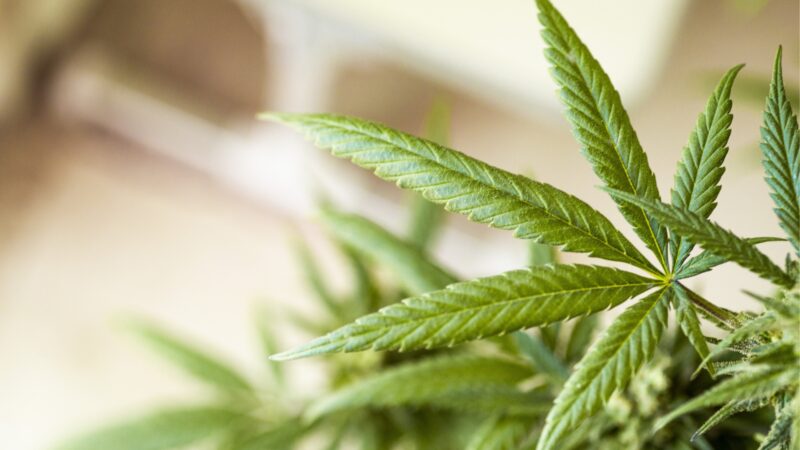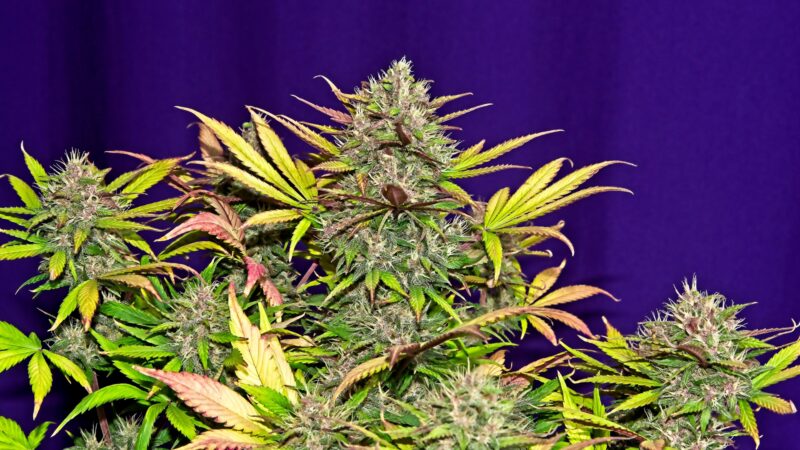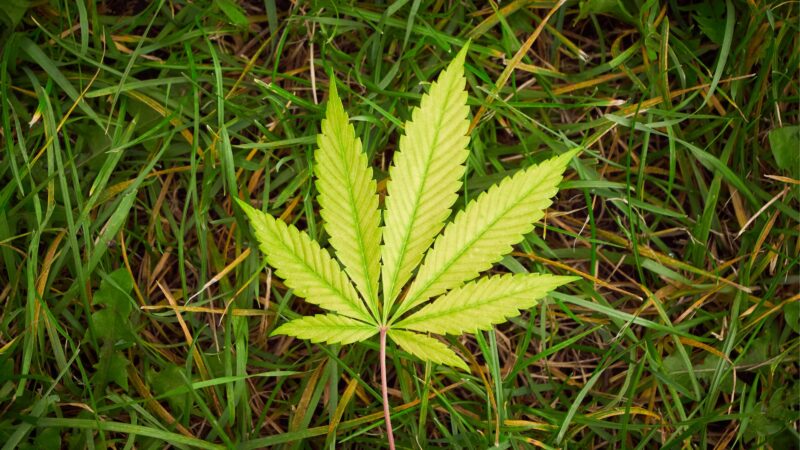Cannabis is one of the most useful plants out there, which makes it easy to see why its cultivation is growing in popularity over the years. But while the cannabis plant is considered hardy, it is still susceptible to certain issues that plague other plants.
Cannabis leaves turning yellow due to bud rot, lighting issues, nutrient deficiencies, over/under fertilization, pH imbalance, temperature problems, watering problems and pest infestation.
In this article, you’ll learn the symptoms to watch out for whenever your cannabis plant is suffering from these issues, as well as the corresponding remedies to help your plant recover. More importantly, you’ll also identify when the change in the leaf’s color is simply part of the plant’s natural cycle.
Read on to know more about preventing your cannabis leaves from turning yellow.
What Are Cannabis Leaves?

Cannabis leaves refer to the part of the cannabis plant that serves as the primary appendage of its stem. It acts as its solar panel and specializes in the plant’s photosynthesis. It absorbs the light from the sun and converts it to energy to support all of the plant’s functions and development.
The cannabis leaves are iconic for their fan-shaped appearance. These leaves have five to seven fingers that may either be stout or narrow, depending on the cannabis variety.
Cannabis leaves are also bright green in color, so when you notice them turning yellow, know that there is an underlying issue that needs to be addressed as soon as possible.
Is It Normal for Cannabis Leaves to Turn Yellow?

It is not always normal for cannabis leaves to turn yellow. As earlier discussed, cannabis plants are known for their bright green foliage. If there is any discoloration, that is always the first sign that something is not right with the plant.
The only exception to this is when the yellow leaves only appear at the bottom of the plant. When this happens, the leaves will simply wilt and fall off the plant as part of its natural processes.
Why Are My Cannabis Leaves Turning Yellow?

When cannabis leaves turn yellow, it’s often a sign that it’s suffering from issues. Depending on the accompanying symptoms, you will be able to determine the issue and act on it accordingly.
The usual culprits that cause cannabis leaves to turn yellow include bud rot, insufficient lighting, nutrient deficiency, pH imbalance, improper weather conditions, insufficient watering, fertilizer issues, and pest infestations.
Bud Rot
Bud rot is quite a common problem that cannabis plants face. It is a disease caused by the fungus botrytis cinerea, which is highly contagious.
If not treated immediately, the fungus will spread throughout the plant’s foliage and may even contaminate nearby plants. And the worst part about it is that bud rot can affect cannabis plants regardless of whether they’re planted indoors or outdoors.
- Symptoms: A cannabis plant suffering from bud rot will develop yellow leaves that look dried up and brittle. You will also notice white or gray molds on different parts of the plant, especially covering the buds.
- How to fix it: To save your cannabis plant from bus rot, the key is to immediately trim away the affected buds and leaves. In doing so, use a sharp pair of garden scissors. But before doing so, make sure to clean it first to prevent contamination.
Also, it is advised to place it in an area where it gets enough air to help dry it up. The fungus Botrytis cinerea thrives on excess moisture, so it’s best to keep the leaves and stems dry to help them recover faster. If there’s no decent breeze, you can opt to use a fan like the iPower Silent Dual 120mm USB Fan with Speed Controller for Indoor Plant instead.
- Multifunctional USB fan: can installed on a plant stand rack or...
- 3 speed adjustable: features a multi-speed controller, you can...
- Low noise and dual ball bearing: each fan is engineered to be...
- Multiple protection: have metal grille on both sides, protect...
- Dimensions: 4.72 x 4.72 x 1.77 inch, air flow: 50 CFM single fan,...
Lighting Issues
It’s probably an understatement to say that cannabis plants love sunlight. In fact, it needs at least 13 hours of exposure to sunlight every day during its growing season. That’s a lot since most sun-loving plants only need around six hours of sunlight exposure every day. Thus, when it’s not getting the right amount of sunlight it needs, its leaves will surely show it.
- Symptoms: Unfortunately, when cannabis plants don’t get enough sunlight, their leaves will eventually turn yellow. It will also look droopy and appear to have stopped growing. Plants need sunlight to grow, after all.
In contrast, cannabis plants that are overexposed to light will have yellow leaves with brown tips. These leaves will also appear dry and brittle.
- How to fix it: Fortunately, it’s easy to remedy light issues with your cannabis plant. In the case where it is not getting enough light, the key is to make sure that it gets a minimum of 13 hours of light per day. If it’s not always bright and sunny from where you are, you can always invest in grow lights like the Barrina BU 2000 LED Grow Light.
- Adjustable Grow Light Panel: Barrina BU 2000 plant grow lights...
- 816 LEDs Full Spectrum LED Grow Light: This indoor grow lights...
- Higher-quality Yields: Our this Barrina grow light full spectrum...
- Dimmable: No Fan, No Noise. The brightness can be adjusted by...
- What You Get: 1 x Barrina indoor plant light 200W, 1 x Network...
In the case of overexposure to light, take your plant immediately away from the light source. Then, you should remove all damaged leaves, especially those with sun spots or burned tips.
Doing so will allow your cannabis plant to regenerate new leaves instead of wasting its energy on reviving severely damaged leaves. Also, bear in mind that cannabis plants only need up to 18 hours of light per day.
Nutrient Deficiencies
Cannabis plants also suffer from nutrient deficiencies. This happens when the plant is not getting the right amount of nutrients from the soil. Particularly, it needs nitrogen to ensure the full development of its foliage.
- Symptoms: It’s easy to tell when a cannabis plant is suffering from nutrient deficiencies because it will have yellow leaves that appear deformed.
- How to fix it: in the case of nutrient deficiencies, make sure to feed your cannabis plant with a fertilizer with a high nitrogen content like the Miracle-Gro Water Soluble All Purpose Plant Food. Regardless of the fertilizer you use, make sure to read the label clearly for dosage instructions. That will prevent you from overfeeding your cannabis and burning its roots.
- Full of essential nutrients, it instantly feeds to grow bigger,...
- Feed every 1-2 weeks
- Use with the Miracle-Gro Garden Feeder or any watering can
- For all flowers, vegetables, trees, shrubs and houseplants
- Safe for all plants, guaranteed not to burn when used as directed
Over/under fertilization
It bears stressing that cannabis plants should only be fed with the right amount of fertilizer. When it’s given too little, it will suffer from stunted growth and malnutrition. But if it’s given too much, its roots might get burned. Either way, both of these cases cause yellow leaves – and ultimately lead to the withering of your plant.
- Symptoms: Aside from yellow leaves, an overfertilized plant will also have burned roots. On the other hand, an under-fertilized cannabis plant will have yellow foliage and will look smaller than usual.
- How to fix it: In the case of an overfertilized cannabis plant, the key is to pour distilled water on the soil to flush out the excess fertilizer. If the damage to the roots seems severe, you have to uproot it and trim away the severely burned roots.
For this, you can use a pair of clean garden scissors like the Fiskars 356922 Multi-Purpose Garden Shears. Make sure to do so carefully so as not to damage the healthy roots.
- 7-IN-1 GARDENING TOOL: Versatile pruning shears for gardening...
- MAXIMUM POWER AND PRECISION: For these garden scissors, trimming...
- LONG-LASTING AND RELIABLE: Trim Scissors with stainless steel...
- QUALITY GARDEN TOOLS: Designed to help you cultivate a better...
- INCLUDES: 1 pair Fiskars Multi-Purpose Hand Pruner with Sheath...
In the case of an under-fertilized plant, you have to give your cannabis more fertilizer. However, make sure to feed your plant according to the recommended dosage.
pH Imbalance
To thrive, cannabis plants need soil with a pH level ranging between 5.0 to 7.0. The acidity in the soil helps break down the nutrients faster so that they can be easily absorbed by the plant. However, if the pH levels exceed this range, that results in a pH imbalance that can cause stress to your cannabis.
- Symptoms: If there is a pH imbalance in the soil, the leaves on your cannabis will turn yellow. Particularly, the discoloration will start at the tip and will move to the rest of the leaves eventually. In its advanced stages, it will also develop spots on the leaves and start to wilt. A pH imbalance will also result in stunted growth, so your cannabis won’t be as large and thick as the others.
- How to fix it: To fix the pH imbalance, you need to add an acidifier or a de-acidifier, depending on what the soil needs. In the case of highly acidic soil, you may use a de-acidifier like Jobe’s 09365 Additive De-Acidifier, which is made of garden lime.
- Organic granular for increasing soils alkalinity, pH; Low pH can...
- Most plants grow well in a pH between 6 and 7, with 6.5-6.8 being...
- Adding garden lime will increase the pH and make those nutrients...
- Helps plants like hydrangeas turn pink; creates a healthier,...
- Easy pour 6 pound bag; apply at planting, reapply 2-3 times a...
On the other hand, if the soil has high alkaline content, then you may use an additive like Jobe’s Organics 09364 Soil Additive, which aims to make the soil more acidic.
- Package contains 6 pounds organic soil acidifier grains and is...
- Soil acidifier is formulated to decrease alkalinity and provide...
- Jobe's organic soil acidifier soil amendment contains no...
- Application is simple and should be done at the time of planting...
- Jobe's organic soil amendment is easily measured to provide the...
Temperature Problems
Cannabis is a tropical plant that thrives where it’s hot and humid. It prefers a temperature range between 66 to 77 degrees Fahrenheit and air moisture content between 40 to 60%. If it is exposed to cooler temperatures, it may freeze over, which can easily lead to its death.
- Symptoms: When cannabis plants live in an environment that’s cool or freezing, they may develop yellow leaves that curl up. These leaves may also appear soft and mushy. In contrast, if there has been an extended heat wave, the leaves will become yellow and dry.
- How to fix it: In the case of extreme cold or heat, the best option is to transfer your cannabis plant indoors, where you can easily control the temperature. After moving the plant, simply continue to give it light and water as usual. In a few weeks, the cannabis plant will recover.
Watering Problems
Cannabis plants need a lot of water – and that’s not an exaggeration. On average, they require two to three gallons of water per day during regular days and around six gallons per day during their growing period. When a cannabis plant doesn’t get enough water, it fails to produce leaves and bulbs, so the foliage may not be as thick.
- Symptoms: An underwatered cannabis plant will have yellow and dry leaves. It will also look smaller than the others due to its stunted growth.
- How to fix it: Fortunately, this is easy to remedy. All you have to do is give your cannabis plant more water than usual. Take note of its daily water requirements so it will not become dehydrated, viz: two to three gallons on regular days and six gallons during its growing period. Its growing period usually falls around June to August.
Pest Infestation
All plants fall prey to pests, and cannabis plants are no exception. The cannabis plant’s usual pests include aphids, fungus gnats, thrips, and spider mites.
- Symptoms: You will know that there is a pest infestation because you can visibly see clusters of tiny spots moving on the plant’s leaves and stems. The leaves will turn yellow since the pests take away the plant’s nutrients from them. You will also observe multiple holes on the leaves, which were chewed upon by the pests.
- How to fix it: The only way to get rid of pests is to use an insecticide. The Safer Brand 5182-6 Neem Oil Concentrate Insecticide is a good option to consider since it’s made from neem oil, which is an organic way to get rid of pests, fungi, and diseases. Even after you have already gotten rid of the pests, you can continue spraying insecticide on your cannabis plants to prevent another infestation.
- Multi-Use Spray - This 3-in-1 spray works as a fungicide,...
- Controls Plants Diseases - This spray can be used to prevent and...
- Kills All Stages of Insects - This spray can be used to eliminate...
- Peace of Mind - This concentrate is OMRI Listed and compliant for...
- Protect a Variety of Plants - Apply it on all roses, flowers,...
When You Shouldn’t Worry About Yellow Cannabis Leaves?
While yellow leaves on your cannabis plant mean that it is experiencing underlying issues, this is only true if the yellow leaves are located at the top of the plant. If the yellow leaves appear at the bottom, then that’s usually a sign that the yellowing is simply part of its natural cycle – especially if the plant looks healthy overall.
This yellowing usually happens when it’s time for the buds to grow. The plant uses most of its energy in producing new bulbs, so the leaves at the bottom are usually left to fall off naturally. This saves the plant the energy that is needed to keep these leaves alive – since their positioning leaves them with little access to light anyway.
List of Sources
The cannabis plant – https://www.sydney.edu.au/lambert/medicinal-cannabis/the-cannabis-plant.html






